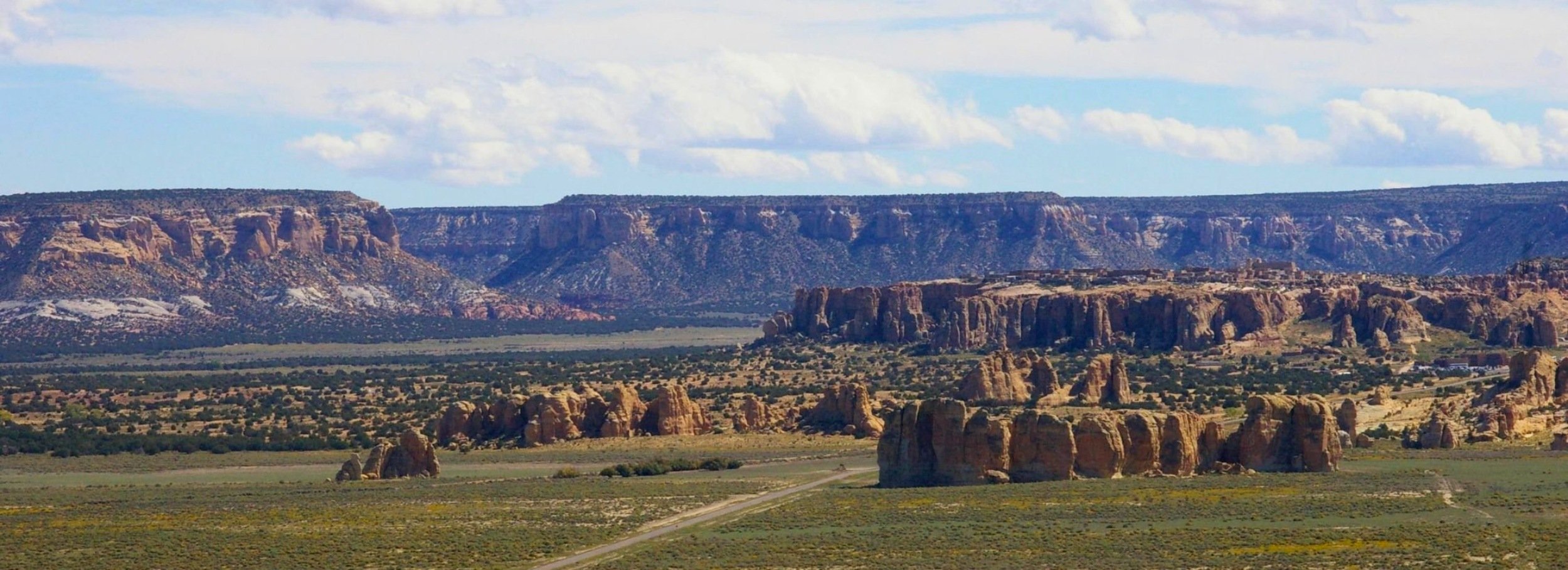Sky City, Cibola County
Current Population: 5,000
Language: Western Keres
Early Social Structure: Agrarian, Exogamous, Matrilineal Clans with Ritual Moieties & multiple Kivas
Location: 431,664 acres in Cibola County
Ancestral Territory: 5,000,000 acres

Click to expand
Acoma & Laguna Traditional Homelands

The Spanish estimated that five thousand to ten thousand people lived in the Acoma village in 1540. In 1582 there were about six thousand Acoma people. In 1776 there were fewer than six hundred.
Stories say that the Acoma once lived across the valley on an enchanted mesa called Katsimo. One day heavy rains separated the ground below from the land above. After that, the people built Sky City on top of a mesa for safety.
Acoma have lived in the area since at least the 11th century. In the 1300s, they built Hak’u (Sky City or Old Acoma) atop a 357-foot sandstone mesa to prevent raids by the Navajo and Apache. This is considered the oldest continuously inhabited community in the country and was named an Historic Site by the National Trust for Historic Preservation in 2007. No attack against Sky City was successful until the Spaniards arrived.
Acoma has three villages in addition to Sky City. These are Acomita, Anzac, and McCartys. Only a few people live in Sky City year-round. It has been preserved by people living traditionally, without modern amenities.
Their beliefs include living in harmony with people and nature; the integration of the spiritual realm with the physical and all other realms - these are not distinguishable entities; the idea of communal lands and tribal ownership as a collectivity of people; and the sharing of goods and the distribution of wealth among tribal members to benefit the whole.
The Spanish destroyed the Acoma kivas on the Sky City mesa. They had the Acoma build a mission on top of where the kivas once were. The Acoma disguised new kivas as homes and continued to practice their religion. Today the Acoma practice both their traditional religion and Roman Catholicism.
Oñate’s Violence
At the end of 1598, some of Oñate's men demanded provisions from Acoma. This was a reserve the Acoma people needed to survive the winter, so they refused. A fight broke out, and 11 colonizers died - including Oñate's nephew. To retaliate for his nephew's death, Oñate murdered 800 people from Acoma Pueblo - men, women, and children. The 507 survivors were put on trial at Ohkay Owingeh and forced into slavery. It is told that 24 men had one foot amputated (though research indicates it was the toes so they would be workable slaves.) Later, upon learning of the atrocities committed by Oñate, the king of Spain exiled him from New Mexico. He was also exiled from Mexico, so he returned to Spain where he lived the rest of his days.
Between 1629 and 1640 missionary priests forced the Acoma people to build a Catholic church made of stone and adobe. The people of Acoma had to bring timber from Mt. Taylor and haul the wood and other materials up to the mesa top. The missionaries tried to force conversion to Catholicism and would punish those who continued to practice their religion.
Although Acoma is far from Santa Fe, the people took part in the Pueblo Revolt of 1680 by killing the local priest and burning the Catholic church they were forced to build. They had to rebuild the church when the Spanish returned.
Ten years after the end of the Mexican-American War, U.S. Congress confirmed that the Acoma, along with other Pueblo tribes, could live on and farm their lands. An illegally built railroad, however, soon caused the loss of some reservation land. This left many Acoma unable to support themselves by farming and so many left their homeland to become mechanics, electricians, and painters.
In the 1900s, the Acoma regained ownership of portions of their homeland, including some major religious sites. In 1970, they received a cash settlement of $6.1 million from the U.S. government for the illegal loss of their lands. The money enabled the Acoma to make several purchases during the 1970s and 1980s that added more than 15,000 acres to their tribal land holdings.
During the last quarter of the twentieth century, the Acoma worked at nearby uranium mines. When the market disappeared, so did the employment. The closing of the Ambrosia Lake Mine meant the loss of jobs for three hundred people on the reservation. Well into the mid-1990s the number of Acoma Pueblo who could not find work remained extremely high. In response, the Acoma began developing new employment opportunities, sich as a robust tourism inudustry and mining natural resources.






